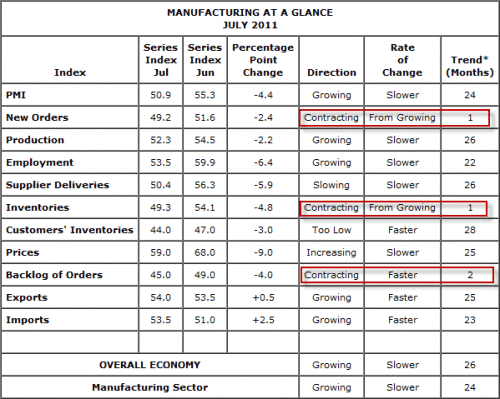Here’s why US manufacturing data have pointed to weakness since March
The ISM Manufacturing Index was released this morning. The data were weak with the overall PMI index printing 50.9 for July, down from 55.3 in June and 53.5 in May. This was well below expectations.
Bradley J. Holcomb, chair for the Institute for Supply Management, which releases the data, said:
The PMI registered 50.9 percent, a decrease of 4.4 percentage points, indicating expansion in the manufacturing sector for the 24th consecutive month, although at a slower rate of growth than in June. Production and employment also showed continued growth in July, but at slower rates than in June. The New Orders Index registered 49.2 percent, indicating contraction for the first time since June of 2009, when it registered 48.9 percent. The rate of increase in prices slowed for the third consecutive month, dropping 9 percentage points in July to 59 percent. In the last three months combined, the Prices Index has declined by 26.5 percentage points, dropping from 85.5 percent in April to 59 percent in July. Despite relief in pricing, however, several comments suggest a slowdown in domestic demand in the short term, while export orders continue to remain strong.
The reality of course is that the data have been weakening since February. Anyone watching the numbers would have seen that the February numbers reported in March were the peak and that this would mean less contribution from manufacturing to GDP growth. Below are a few highlights of my reporting of the most recent ISM numbers since January.
- January 2011 report (ISM Manufacturing Report bullish for US economy): “I like the backlog of orders item as a sign of continuing robust numbers. it popped last month and is a very robust 58.0%. New Orders are also at multi-year highs. On the other hand, prices are starting to become a problem. 81.5% on the prices paid metric is extremely high and signals either price pass throughs to consumer prices are imminent or that margins will take a hit. 60.8 is about the highest reading we have seen on the PMI in the last 28 years.”
- February 2011 report (Manufacturing still firing on all cylinders): “I am going to call a top here however. If you look back at the historical data, there have been no readings higher than this in nearly three decades. The last ISM number higher than 61.4% was a monster 69.9% reading from December 1983. So what does that mean going forward. In terms of growth of the manufacturing sector, it means that we are hitting maximum growth. I would expect the manufacturing sector to add less to overall GDP going forward.”
- April 2011 report (Has the US manufacturing sector’s growth already started its cyclical descent?): “The April 2011 Manufacturing ISM Report On Business came out today and confirmed the slight downward path we have seen since I wrote that paragraph two months ago. Mind you, 60.4% is still a very robust reading. Nevertheless, I still believe the manufacturing sector’s contribution to overall GDP growth has peaked.”
- May 2011 report (ISM manufacturing index confirms growth slowdown): “The bottom line for me is that the soft patch in and of itself is not a problem. There is always some sort of mid-cycle slowdown. The real problem for economic growth bulls (and risk assets) is that this particular soft patch is increasingly likely to be met with austerity and contractionary fiscal policy.”
- June 2011 report (Despite growth slowdown, ISM manufacturing index ticks up): “Yesterday’s monthly manufacturing index from ISM was in line with previous bullish data in the manufacturing sector showing slightly more elevated levels. Yes, the numbers were higher but they were only marginally so. The numbers were better, right across the board, including on the inflation front where the prices sub-index fell.”
While the potential still exists for manufacturing to tick back up, the jobs picture and the fiscal and monetary backdrop are not supportive of this outcome. The inflation backdrop is the best part about this picture, with that subindex having dropped substantially since February’s peak at 82%.
Given that the manufacturing sector at 50.9% is very close to contracting, any further slowdown would put the sector into recession, meaning manufacturing would detract from GDP growth. We are very close to this outcome. Note that the ISM states its PMI manufacturing index needs to be below 42.5 percent, over a period of time, before one could assume a contraction of the overall economy.

I love how you break this out…very troubling